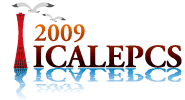ICALEPCS 2009
THP053
Experience with the SLAC Controls Architecture Evolving to the Needs of the LCLS
A.Chan, D.Fairley, D.Rogind, E.Grunhaus, E.Williams, G.R.White, H.Shoaee, P.Chu, P.Krejcik*, S.Allison, S.Chevtsov, M.Zelazny (SLAC)
The successful commissioning this year of the LCLS has been the culmination of a significant effort to integrate new, state-of-the-art controls with legacy controls of the SLAC linac. A distributed controls system of EPICS IOCs and Linux servers operates in conjunction with an older, centralized VMS system based on CAMAC and micros. High-level Java applications and scripts written in Matlab provide data acquisition and analysis tools for diagnosing, tuning and optimizing the machine. A RDB unites the configuration control, online modeling and reference beam data within a uniform schema. The Aida data access tool allows applications transparent access to data from either control system and has allowed engineers to control migration to new platforms without requiring changes to application code. Emphasis has shifted from using our SLC-aware IOC development to supporting a data bridge in the opposite direction to provide access for burgeoning applications on new platforms to data from the old control system. The challenge has been to provide such data synchronously with the timing system on a pulse-by-pulse basis at 120 Hz to support beam-based feedback and other applications.

